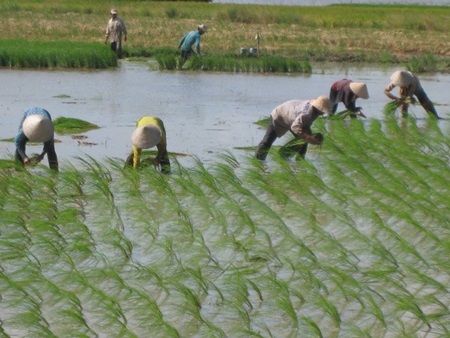The El Nino weather event that began last year and has continued into early 2016 has negatively impacted agricultural production in several countries.

Vietnam expected to suffer slight fall in paddy yield and
rice production due to impacts of El Nino
This has caused a fall in rice supply and stockpiles in many parts of the world.
The unfavorable weather condition has forced many countries that traditionally import rice such as the Philippines, Indonesia and China to increase imports to maintain rice stockpiles for ensuring food security.
India, Thailand and Vietnam, the three largest rice exporters in the world, have seen a sharp fall in their rice output.
Dry conditions caused by the El Nido weather phenomenon in two consecutive years of 2014 and 2015 have severely affected India's agricultural production. The world's largest rice exporting country's stockpile is at such a low level that the country has had to cut down its rice export by a huge amount.
In the ASEAN bloc, the world's second and third-largest rice exporters Thailand and Vietnam have also suffered a reduction in their rice stockpiles. Recently, Thailand's rice stockpile fell to 13.5 million tonnes, of which only seven million tonnes are good enough for consumption. About three to four million tonnes of that stockpile can be used only for producing alcohol. The rest cannot be used due to its poor quality.
Thailand's paddy yield in the upcoming crop is expected to fall by three to four per cent, equivalent to two to three million tonnes of rice. During the whole of 2016, rice production in Thailand is expected to drop by four to five million tonnes, the heaviest fall since 2000.
The country will not increase its rice exports this year.
Vietnam, the world's third-largest rice exporter after Thailand, is expected to suffer slight fall in paddy yield and rice production this year.
The Philippines will fail to achieve its target of producing enough rice for domestic consumption because of the El Nino effect. In the first quarter of 2016, the country's paddy yield is expected to fall by five per cent. The rice imports of the country will be closely monitored by local traders, because that will decide the number of countries the Philippines has to buy rice from.
Last year, Manila suggested buying additional rice from its two main suppliers, Vietnam and Thailand, after the country's paddy output fell.
The regional rice market has seen a noticeable rise in demand of late for imported rice. The Philippines will purchase 400,000 to 600,000 tonnes of rice in February. In 2016, it will buy an additional 800,000 tonnes of rice to meet the domestic demand.
Indonesia will import 800,000 tonnes of rice between February and April. The two markets will import rice during the winter –spring crop of 2015 – 2016 of Vietnam. It is said that the situation is very favourable for Vietnam to conduct negotiations.
According to experts, Vietnam and Thailand should coordinate in bidding to get good prices in the contract to sell rice to the Philippines. It is possible that Thailand will not sell much rice because of its current crop failure.
Thai enterprises also appear to be discouraged after the recent bidding contracts for the sale of rice to the Philippines and Indonesia. Most of the Thai enterprises involved in the trade pact faced losses, because after selling the cereal, rice prices in Thailand increased sharply, while much of the rice stockpile was not owned by the exporting enterprises, but by processing factories.
Thai enterprises are now being more careful, following the current problems in paddy production due to the El Nino impact. With the reduction in paddy yield, the rice price will increase after the contracts are signed.
Thailand will not take a risk by exporting a large quantity of rice to other countries. Thailand can only give the Philippines 40 per cent of its demand and 300,000 to 400,000 tonnes of rice to the Indonesian market.
"Vietnam should not conduct only a single negotiation with Indonesia, but conduct the negotiations in several phases to get good prices. Vietnam would have made a lot of profit if the negotiations had been divided into several parts for selling one million tonnes of rice to Indonesia recently," an expert said.
"The first lot can be sold at a reasonable price, but the second lot can be sold at a slightly higher price, and the third lot should be sold at a price higher than the second lot," the expert said.
The most important thing is that China will import a lot of rice after the Lunar New Year holiday. Once China imports rice, the world's rice market becomes much more animated. If the cold weather continues, vegetables and paddy being cultivated in China will perish and the demand for imported food in the country will increase sharply.
Of course, a huge amount of rice will be imported from Vietnam.
"The Philippines, Indonesia and especially China will increase rice imports and the rice price in Vietnam will improve dramatically. If local rice enterprises start purchasing rice, they will gain a lot. However, the problem is of capital, which, in turn, depends a lot on banks," the expert said.

Leave your comment on this story